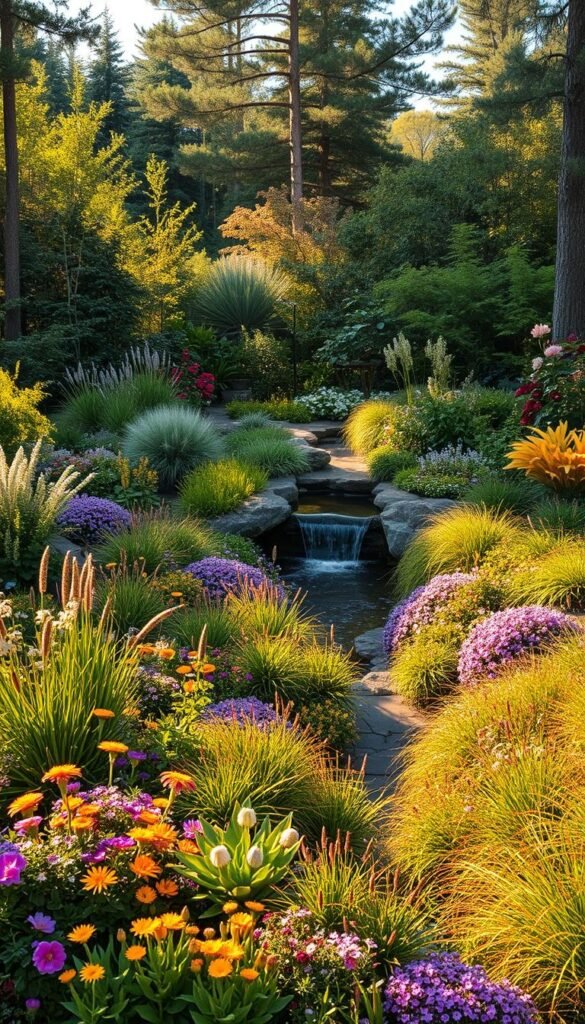Imagine stepping outside to find your outdoor space buzzing with life. Birds flit between branches, butterflies dance over blossoms, and bees hum through the air. Your patch of earth holds untapped potential to become part of something bigger – a network of green spaces that help nature thrive.
Entomologist Douglas Tallamy reveals a crucial truth: native plants form the bedrock of thriving ecosystems. These species evolved alongside local animals, developing relationships where specific plants become lifelines. Monarch caterpillars, for instance, survive exclusively on milkweed – they literally taste-test leaves with their feet before eating.
Urban sprawl and farmland have fractured natural landscapes, leaving wildlife stranded in shrinking habitats. But here’s the good news: strategic plant choices in your space can bridge these gaps. By selecting regionally appropriate vegetation, you create stepping stones that let creatures safely travel, feed, and reproduce.
This approach doesn’t demand a complete yard overhaul. Even container plants or a modest flowerbed contribute when neighbors join the effort. Together, these pockets form ecological pathways that strengthen biodiversity across entire communities. Ready to explore how your green thumb can nurture both plants and wildlife?
Getting Started with Wildlife Corridors in Your Garden
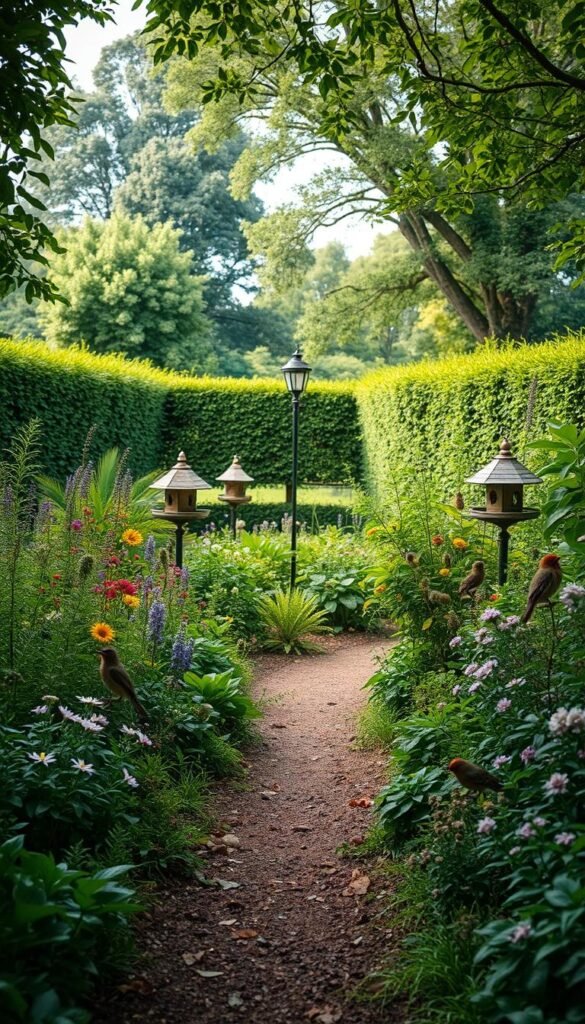
Transforming your outdoor space into a nature highway begins with smart planning. Think of your property as a puzzle piece that could link fragmented habitats across the neighborhood. A simple sketch of your land reveals where to add life-supporting greenery.
Understanding the Concept of Wildlife Corridors
These natural pathways act like subway lines for creatures. They connect larger areas through:
- Thick hedges that shelter nesting birds
- Flowering borders offering nectar pit stops
- Tree canopies creating aerial bridges
Urban ecologist Dr. Jane Smith notes: “A six-foot-wide planting strip can triple wildlife movement compared to bare lawns.” Start by peeking over fences – neighboring trees could become your corridor’s endpoints.
Identifying Gaps and Opportunities in Your Yard
Grab paper and mark:
- Existing trees and shrubs
- Walls or fences blocking movement
- Sunny spots perfect for wildflowers
Notice where animals get stuck. A bare patio between two bushes? That’s a habitat gap waiting for climbers or groundcover. Prioritize planting along property edges where shy creatures feel protected.
Why Native Plants and Insects Matter for Your Ecosystem
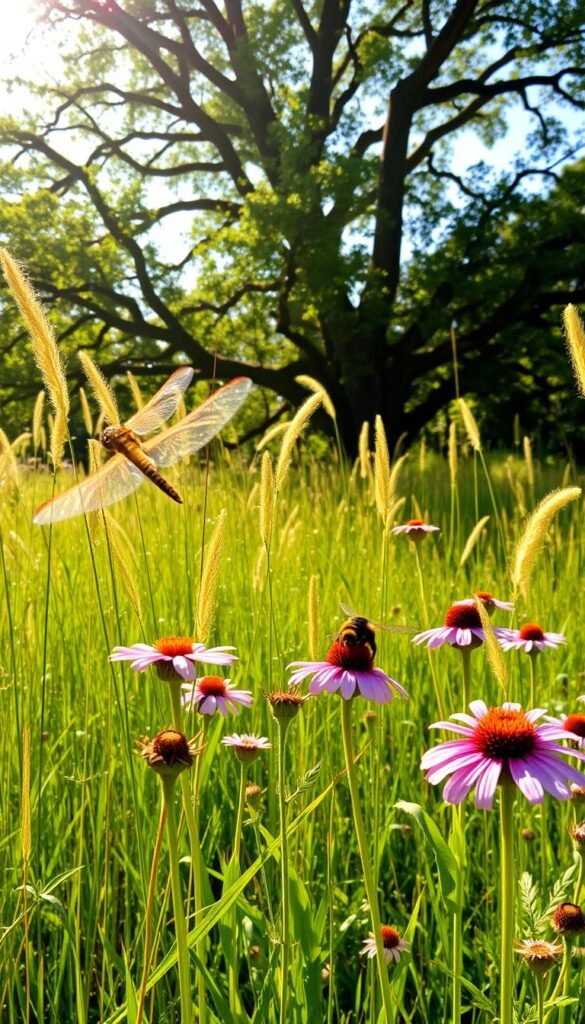
Picture this: One out of every three land animals crawling, flying, or hopping around you is an insect that eats plants. These tiny creatures form nature’s essential workforce, connecting soil to treetops through intricate food chains. Your choice of vegetation directly shapes which species thrive – or disappear – from your local environment.
The Role of Native Species in Local Food Webs
Native plants and insects share an ancient dance perfected over millennia. Monarch caterpillars demonstrate this perfectly – their feet contain sensors that only recognize milkweed leaves as food. Non-native flowers might look pretty, but they often lack the chemical cues local insects need to survive.
This specialization matters because 96% of nesting songbirds rely on insects to feed their chicks. As entomologist Doug Tallamy observes: “A single chickadee family needs 6,000-9,000 caterpillars to raise one brood.” Without native plants supporting insects, backyard birds would starve mid-season.
How Insects Support a Healthy Garden
Your garden’s buzzing residents work overtime to maintain balance. Ladybugs devour aphids, while ground beetles hunt slugs under cover of darkness. Even wasps contribute – parasitic varieties lay eggs in crop-damaging pests, naturally controlling outbreaks.
By planting region-specific flowers and shrubs, you create a self-sustaining ecosystem. Native oak trees support over 500 insect species compared to just 5 for non-native ginkgos. More insects mean better pollination for your vegetables and more birds singing in your trees – all without chemical interventions.
Eco Garden Inspiration: Creating Wildlife Corridors in Your Yard
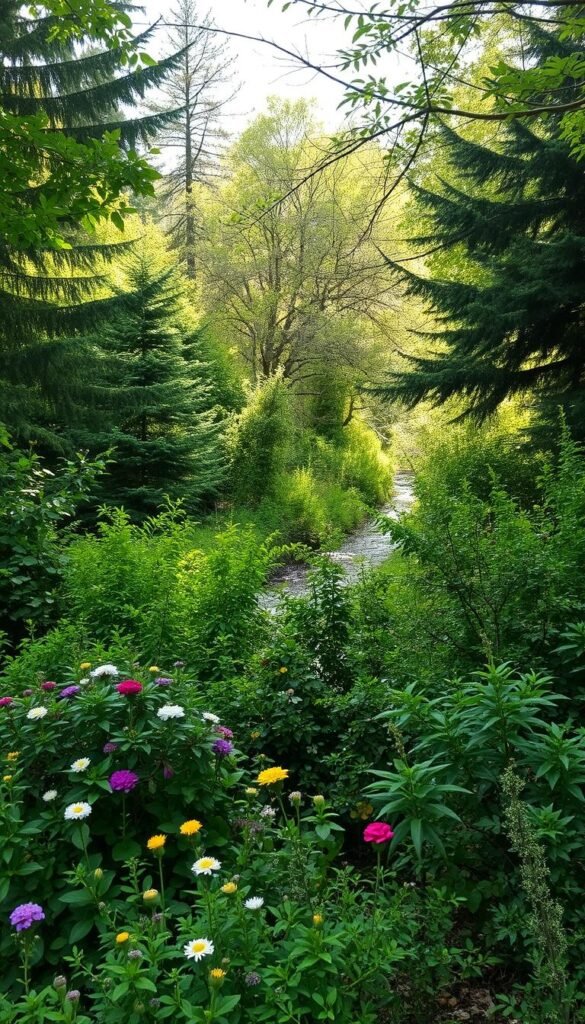
Think of your outdoor space as a living bridge. The right mix of woody plants creates highways for creatures while boosting biodiversity. Trees and shrubs form the backbone of these pathways, supporting 10x more species than flowers alone.
Powerhouse Plants for Maximum Impact
Start by swapping invasive species with native alternatives. Replace Norway maples with red maples – their vibrant fall colors rival any non-native tree. For year-round interest, try serviceberry shrubs that offer spring blooms and summer berries.
Oak trees reign supreme in supporting local ecosystems. A single mature oak hosts over 500 animal species, from leaf-munching caterpillars to nut-hoarding squirrels. As Doug Tallamy’s research shows: “No other tree genus comes close to oaks’ ecological value.”
Layered Planting for Habitat Connectivity
Create vertical diversity with these layers:
- Canopy trees (oak, maple)
- Understory trees (dogwood, redbud)
- Fruiting shrubs (blueberry, elderberry)
- Groundcover (wild ginger, ferns)
This structure provides shelter at every height. Blueberry bushes serve double duty – their twiggy bases hide ground-nesting birds, while berries feed hungry migrants. For gardeners short on space, columnar trees like hornbeams make perfect green walls that don’t spread wide.
Remember: Each native plant acts like a rest stop along nature’s highway. Cluster several together, and you’ve created a thriving waystation that keeps ecosystems connected.
Designing Your Garden for Year-Round Wildlife Benefits
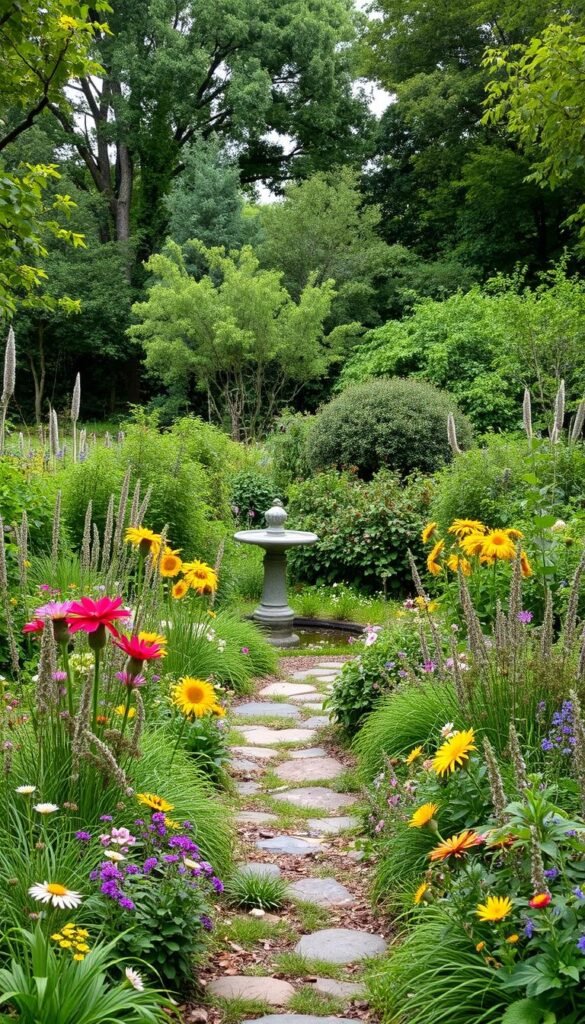
Your backyard can become a bustling hub for nature’s travelers with thoughtful design choices. Focus on three essentials: layered vegetation, reliable water access, and staggered food sources. These elements work together to support animals through all seasons while creating visual interest.
Layering Plants for Structural Diversity
Mimic natural forests by stacking plants vertically. Start with tall trees like oaks that offer canopy shelter and acorns. Below these, add flowering dogwoods and serviceberry shrubs – their spring blooms feed bees, while berries sustain birds in summer. Finish with ground-hugging plants like wild ginger that protect soil and host beneficial insects.
Adding Water Features and Natural Shelters
All creatures need hydration. A bird bath near bushes gives safe drinking spots, while a small pond with sloping edges supports frogs and dragonflies. For extra appeal, add a dripping fountain – the sound attracts birds from yards away. Stack fallen branches nearby to create instant hiding spots for chipmunks and beetles.
| Season | Plant Features | Wildlife Benefit |
|---|---|---|
| Spring | Serviceberry blooms | Early nectar for bees |
| Summer | Purple coneflowers | Seed heads for finches |
| Fall | Oak trees | Acorns for squirrels |
| Winter | Winterberry holly | Berries for migrating birds |
Ensuring Seasonal Food Sources
Plan for continuous blooms and fruits. Early crocuses kickstart spring feeding, while asters provide late fall nectar. Winterberry holly keeps birds fed during frosty months. Remember: native plant gardening ensures your selections align with local species’ needs.
Leave seed heads standing through winter – they’re natural bird feeders. Evergreen shrubs like juniper offer year-round shelter when other plants go dormant. With these strategies, your space becomes a lifeline that supports wildlife every single day.
Maintenance and Sustainable Practices for Your Wildlife Corridor
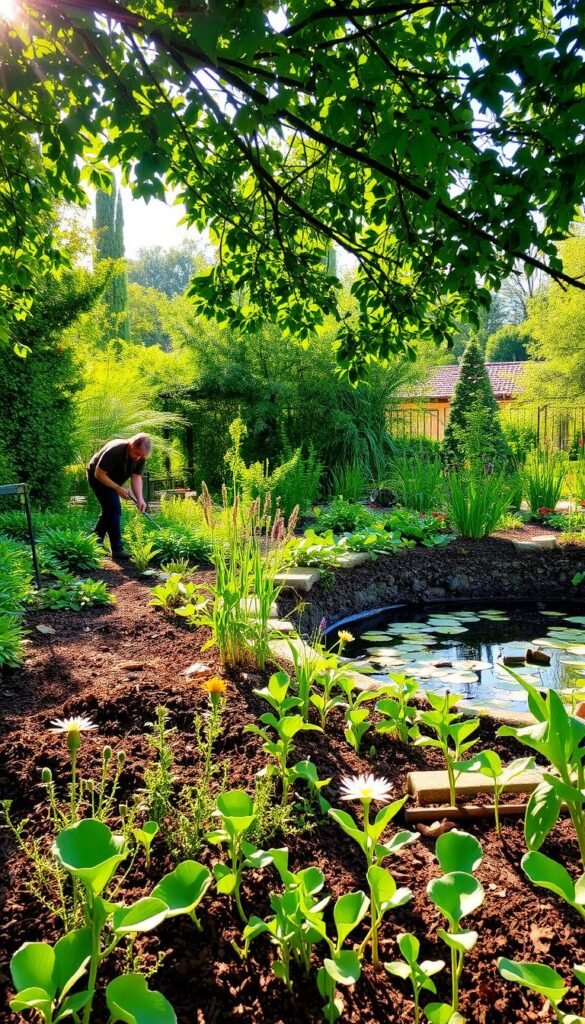
Your green sanctuary thrives when care routines align with nature’s rhythms. Thoughtful upkeep preserves habitats while letting plants and animals flourish naturally.
Adopting Eco-Friendly Gardening Techniques
Chemical pesticides might solve one problem but create ten others. Neonicotinoids linger in soil for years, poisoning bees long after aphids vanish. Instead, invite nature’s pest controllers: lacewings devour 1,000 aphids weekly, while frogs feast on slugs near ponds.
Rethink lawn care – mow less often and keep blades high. This lets clover and dandelions bloom, providing food for pollinators. Leave leaf piles in corners to provide shelter for beetles and hedgehogs. As one landscaper notes: “Messy gardens often host the richest ecosystems.”
Timing Garden Tasks to Support Wildlife
Delay major pruning until late winter. Birds rely on berries and seed heads through cold months, while hollow stems house overwintering insects. If you’re building pollinator-friendly spaces, avoid spring cleanups when nests are active.
Create brush piles in fall – they become winter hideouts for rabbits and insects. Let fallen leaves decompose naturally, enriching soil and hiding spots for ground dwellers. By syncing tasks with seasons, you protect life cycles while reducing labor.
Bringing It All Together for a Thriving Wildlife Haven
Your outdoor space holds more power than you think – it’s a puzzle piece in nature’s grand design. By choosing native plants that support local species, you help stitch fragmented habitats back together. Even a single shrub can become a rest stop for traveling birds or hungry bees.
Start small: replace one non-native plant each season with a regional powerhouse like oak or milkweed. These selections deliver the biggest ecological punch, feeding countless insects and birds. As Doug Tallamy suggests, thoughtful swaps matter more than total overhauls – your patio pots count too!
When neighbors join in, magic happens. A cluster of yards with native perennials creates safe pathways for fireflies to glow and caterpillars to crawl. Your choices ripple outward, restoring balance to landscapes one plant at a time. Every rooted cutting whispers, “Welcome home” to creatures seeking shelter.

